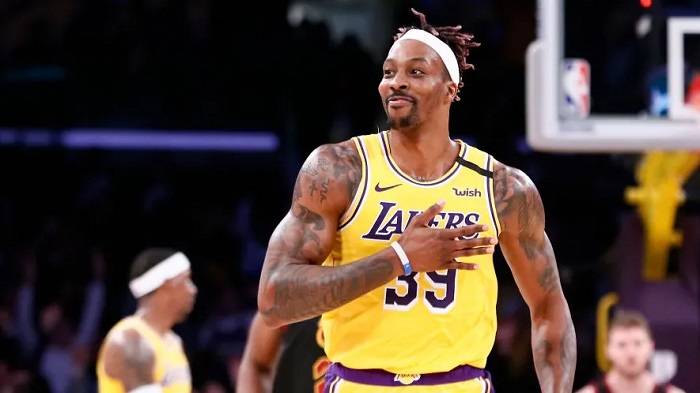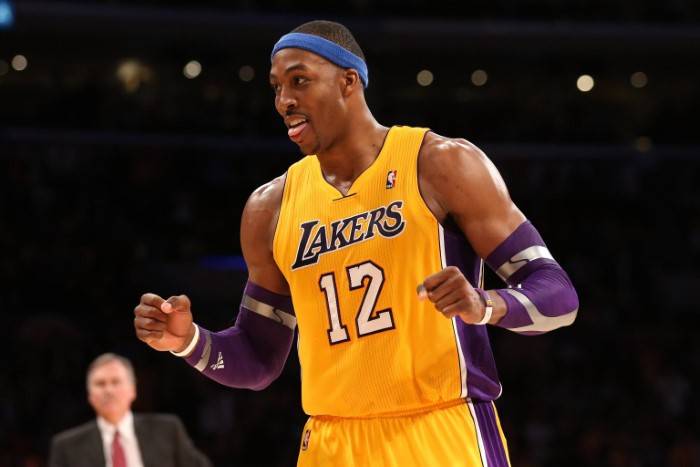Dwight Howard, a name synonymous with power and dominance in the NBA, has left an indelible mark on the sport of basketball. Known for his incredible athleticism, defensive prowess, and a knack for grabbing rebounds, Howard’s career has been a fascinating journey of highs and lows. This comprehensive guide delves into the various aspects of Dwight Howard’s basketball strategies, his performance over the years, and the benefits he has brought to every team he has been a part of.
Dwight Howard, born on December 8, 1985, in Atlanta, Georgia, is one of the most notable centers in NBA history. Standing at 6 feet 10 inches and weighing around 265 pounds, Howard’s physical presence has been a significant factor in his success on the court. Over his career, Howard has played for several NBA teams, including the Orlando Magic, Los Angeles Lakers, Houston Rockets, Atlanta Hawks, Charlotte Hornets, Washington Wizards, and the Philadelphia 76ers. His journey in the NBA has been characterized by a blend of personal achievements, team contributions, and a fair share of controversies. This blog post will explore Howard’s career in detail, focusing on his strategies, performance metrics, and the advantages he brings to his teams.
Dwight Howard’s Strategies on the Court
Defensive Mastery
One of Dwight Howard’s most notable strategies on the court has been his defensive play. Howard’s ability to block shots and protect the rim has made him a three-time NBA Defensive Player of the Year. His defensive strategy is built around a few key elements:
- Shot Blocking: Howard’s timing and understanding of opponent tendencies make him a formidable shot-blocker. He uses his wingspan and vertical leap to challenge shots effectively, often altering the course of the game by deterring opponents from attempting shots in the paint.
- Rebounding: As a center, Howard’s rebounding skills are among the best in NBA history. He employs a combination of positioning, anticipation, and physicality to dominate the boards, both offensively and defensively. This not only prevents second-chance points for the opposition but also creates additional scoring opportunities for his team.
- Positioning and Footwork: Howard’s defensive positioning and footwork have been crucial in his ability to guard multiple positions. His agility and quick reflexes allow him to switch onto smaller players without compromising his defensive stance, thus maintaining the integrity of his team’s defensive schemes.
Offensive Strategies
While Dwight Howard is primarily known for his defense, his offensive strategies have also played a significant role in his career.
- Post Play: Howard’s offense is heavily reliant on his post play. He uses his size and strength to establish position in the low post, where he can either back down his defender for a close-range shot or use a quick spin move to create space. His repertoire includes hooks, drop steps, and an occasional mid-range jumper.
- Pick and Roll: Howard has also been effective in the pick-and-roll game, particularly during his time with teams that had strong playmakers. His ability to set solid screens and then roll to the basket with authority makes him a constant lob threat, forcing defenses to react and often opening up perimeter shooting opportunities for his teammates.
- Transition Offense: Due to his athleticism, Howard is also a valuable asset in transition. He runs the floor well for a big man, often beating his defender down the court and positioning himself for easy baskets. His ability to finish above the rim makes him a target for fast-break opportunities.
Performance Analysis Over the Years
Dwight Howard’s performance in the NBA can be divided into different phases, each characterized by distinct achievements and challenges.
Orlando Magic Era (2004-2012)
Howard was drafted by the Orlando Magic as the first overall pick in the 2004 NBA Draft. His time with the Magic was the most productive period of his career.
- Statistics and Impact: During his eight seasons with Orlando, Howard averaged 18.4 points, 13 rebounds, and 2.2 blocks per game. He was a dominant force in the paint and led the Magic to the NBA Finals in 2009.
- Achievements: Howard won three consecutive NBA Defensive Player of the Year awards (2009-2011) and was selected to five All-NBA First Teams during his tenure with the Magic. He was also a six-time All-Star with Orlando.
- Team Dynamics: Howard’s presence transformed the Magic into a defensive powerhouse. The team’s strategy revolved around his ability to defend the rim and clean the glass, allowing perimeter players to pressure the ball more aggressively.
Los Angeles Lakers and Houston Rockets (2012-2016)
Howard’s move to the Lakers in 2012 was highly anticipated but ultimately did not yield the desired results.
- Statistics and Impact: Howard’s performance with the Lakers was solid but not at the level expected. He averaged 17.1 points and 12.4 rebounds per game during the 2012-2013 season. His time with the Houston Rockets (2013-2016) saw him average 16 points and 11.7 rebounds per game.
- Challenges: Howard faced several challenges, including back injuries and a lack of chemistry with teammates like Kobe Bryant in Los Angeles. His role in Houston was somewhat diminished due to a different offensive focus centered around James Harden.
- Team Dynamics: In Houston, Howard’s contributions were more defensive than offensive. He provided the Rockets with a strong interior presence, but the team’s pace and space philosophy under coach Mike D’Antoni reduced his offensive involvement.
Later Years and Team Changes (2016-2021)
Howard’s later years saw him moving between several teams, including the Atlanta Hawks, Charlotte Hornets, Washington Wizards, and a return to the Lakers.
- Statistics and Impact: Despite a decline in his offensive production, Howard remained an effective rebounder and shot-blocker. He averaged around 12 points and 10 rebounds per game during this period, demonstrating his continued value as a role player.
- Role Evolution: Howard’s role evolved from being a primary star to a veteran presence and mentor. His experience and leadership became valuable assets, especially during his second stint with the Lakers, where he played a crucial role in their 2020 NBA Championship run.
- Team Dynamics: Howard adapted to different team environments, contributing as a backup center and providing energy off the bench. His willingness to embrace a reduced role showcased his maturity and understanding of his place in the league at this stage of his career.
Benefits to Teams and Overall Contributions
Defensive Anchor
Howard’s ability to anchor a defense has been his most significant contribution to every team he has played for. His presence in the paint deters drives and forces opponents to alter their offensive strategies. Even in his later years, Howard’s shot-blocking and rebounding remained impactful, making him a valuable defensive asset.
Veteran Leadership and Mentorship
As Howard transitioned into the latter stages of his career, his role as a mentor became more pronounced. Younger players benefited from his experience and insights into the game. Howard’s journey from a superstar to a role player provided valuable lessons in humility, work ethic, and the importance of team dynamics.
Offensive Efficiency
Despite being known primarily for his defense, Howard’s offensive efficiency cannot be overlooked. His ability to score efficiently in the paint and finish lobs added a crucial dimension to the teams he played for. His offensive rebounding also provided numerous second-chance opportunities, contributing to the team’s overall scoring efforts.
Locker Room Presence and Team Chemistry
Howard’s presence in the locker room has been both a challenge and a benefit throughout his career. Early in his career, his personality sometimes clashed with teammates and coaches, but in his later years, he became more of a unifying presence. His enthusiasm and positive attitude, especially during his time with the Lakers in 2020, helped foster a strong team spirit.
Benefits of Dwight Howard’s Playing Style
Adaptability and Versatility
One of Howard’s key benefits to any team is his adaptability. Over the years, he has shown the ability to adjust his playing style to fit the team’s needs, whether as a primary scorer, a defensive anchor, or a veteran role player. This versatility has allowed him to extend his career and remain valuable to multiple teams.
Physical Dominance
Howard’s physicality has always been a significant asset. His strength, athleticism, and size make him a matchup nightmare for most opponents, particularly in the low post and around the rim. This physical dominance translates to both offensive and defensive ends, where he can overpower opponents and control the paint.
High Basketball IQ
Howard’s understanding of the game has improved over the years, especially in reading plays and positioning himself defensively. His ability to anticipate opponent moves and react accordingly has made him a more effective defender and team player.
Rebounding Excellence
Howard’s rebounding skills are among the best in the history of the NBA. His ability to grab boards on both ends of the court provides his team with more scoring opportunities and limits the opponent’s chances. Rebounding is a critical aspect of basketball, and Howard’s prowess in this area has been a consistent benefit throughout his career.
Related Post:
Dwight Howard’s career has been a fascinating journey marked by numerous achievements, challenges, and reinventions. From his early days as a dominant force with the Orlando Magic to his role as a veteran leader with the Los Angeles Lakers, Howard has continually adapted and contributed to his teams in meaningful ways. His strategies, performance, and the benefits he brings to his teams underline the versatility and impact of his game. Whether through his defensive mastery, offensive efficiency, or leadership qualities, Dwight Howard has left a lasting legacy in the NBA. As he continues his career, his ability to evolve and adapt will remain a testament to his enduring value in the league.




